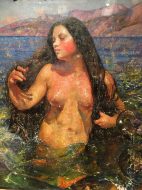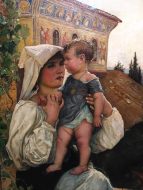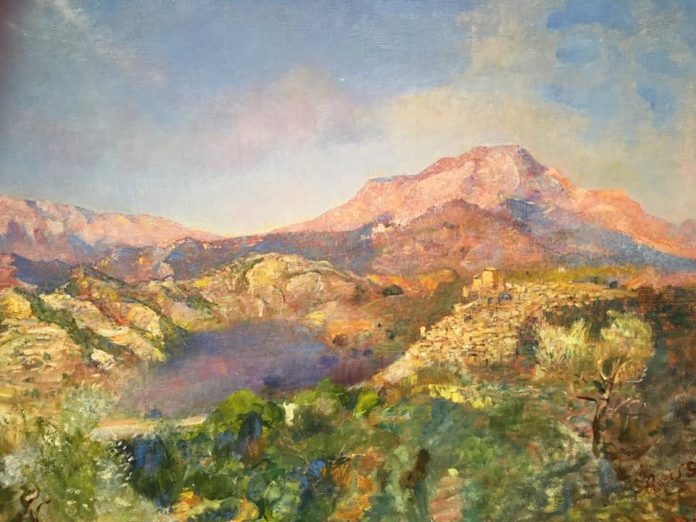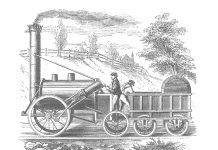Back in 1923, Manchester Art Gallery put on an exhibition to celebrate a Manchester born artist becoming the first women to be elected as an Associate Member of the Royal Academy .
Already seventy eight when she got the award, Hulme born Annie Swynnerton had spent much of her career fighting against the conventions of the male dominated profession.The exhibition ensured her legacy and now nearly one hundred years later, the Gallery is once again putting on an exhibition dedicated to the artist.
Painting Light and Hope features 30 paintings from across Swynnerton’s career, including 11 from Manchester Art Gallery’s collection with further loans from public galleries including the Royal Academy Collection, Tate and the Walker Art Gallery, Liverpool. The exhibition also features a number of rarely seen paintings on loan from private collections
 Annie’s early training took place in the city, her father a successful solicitor,moved from Hulme to Prestwich, but the family would fall on hard times,and along with two of her sisters,she signed up to train at the Manchester school of Art.
Annie’s early training took place in the city, her father a successful solicitor,moved from Hulme to Prestwich, but the family would fall on hard times,and along with two of her sisters,she signed up to train at the Manchester school of Art.
She won a scholarship for £11 and used it to travel to Rome,along with her fellow artist Susan Isabel Dacre, whom she would found the Manchester Society of Women Painters in 1879 with.
The Society was a way for them to vent their frustrations of not having the same access as their male brethren, they were, for example not allowed to paint nudes in real life.The move worked, gaining a reputation in the city, the Manchester Academy for Fine Arts would finally admit them in 1884 and in 1895 Swynnerton was invited to serve on the hanging committee for the Autumn Exhibition at the Walker Art Gallery, the second woman to do so.
So to the exhibition itself, which showcases a range of work across her career.She was commissioned by the Portico Library to paint William Gaskell, this was a rare thing for a women to do in 1879, the connections she made with the Gaskells would put her in touch with London artists and a move down to the capital
One of the key things that made her different was her use of light, seen in her paintings of Italy, she discovered the painting of the outdoors.
The first painting you will see in the exhibition an Italian mother and child shows her use using the natural light to model the forms in the painting.It was produced in Rome, where she had moved after her marriage in 1883, and its one of a series of contemporary Italian women and children that she would produce.
 Her use of light to model forms of the painting was almost unique, across from this picture is the Italian landscape picture showing Annie’s use of a colourful pallet, it was an independent style but she was influenced by the impressionists and Pre Raphaelites
Her use of light to model forms of the painting was almost unique, across from this picture is the Italian landscape picture showing Annie’s use of a colourful pallet, it was an independent style but she was influenced by the impressionists and Pre Raphaelites
She challenged other conventions as well. In the exhibition are three interpretations of the nude, denied access in The UK, she went to Paris to learn the art form.Cupid and the Psyche here is on loan from Gallery Oldham, Oreads is on loan from the Tate, and show her using a realistic interpretation of the female form, Oceanid shows the sense of a real women, sunburnt and buxom.
Swynnerton was heavily involved in women’s politics and the suffrage movement, they would take up many of her female figures in their campaign posters and literature.
Her most famous reputation used was that of Joan of Arc, the painting itself has been lost to the world but you can see a similar style in Illusions, a poignant work showing the potential of a young women, the armour is well fitting and she wears it comfortably.It is thought that it was so named because at the time, what is represented for the female appeared so far far in the future that it was simply an illusion.
Here also is her portrait of Dame Millicent Garrett Fawcett, displayed at the Tate before it came to Manchester, she is middle aged and Annie doesn’t mask the lines on her face and around her eyes, Dame Fawcett is a real human being enclosed by the robes of the University of St Andrews having been given an honorary degree by them.
Maybe though it is the final image that will leave you with the greatest impression.The Montagna Mia painted in 1923, ten year before her death. Here her brushwork is more loose and abstract, a female form merging into a landscape, showing here awareness of modernist works, and taking note of the work of Rodin and Cezanne.A freedom of vision perhaps that he election to the Royal Academy gave her and the legacy that she left behind for women artists to follow.
In her autobiography Oil Paint and Grease Paint (1936), artist Dame Laura Knight, said: “We women who have the good fortune to be born later than Mrs Swynnerton profit by her accomplishments. Any woman reaching the heights in the fine arts had been almost unknown until Mrs Swynnerton came and broke down the barriers of prejudice.”
Annie Swynnerton Painting Light and Hope runs at Manchester Art Gallery until the 6th January 2019.







